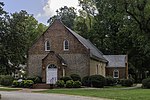The Hermitage (Virginia Beach, Virginia)
1700 establishments in VirginiaColonial architecture in VirginiaHampton Roads, Virginia Registered Historic Place stubsHouses completed in 1700Houses in Virginia Beach, Virginia ... and 2 more
Houses on the National Register of Historic Places in VirginiaNational Register of Historic Places in Virginia Beach, Virginia

The Hermitage, also known as Devereaux House, is a historic home located at Virginia Beach, Virginia. The original section was built about 1700, with two later additions. It is a 1+1⁄2-story, four-bay, Colonial era frame dwelling. The second portion was constructed by about 1820, doubling the size of the dwelling, and the final portion was added in 1940. Also on the property are three outbuildings, as well as a large subterranean brick cistern, now part of the basement to the house.It was added to the National Register of Historic Places in 2008.
Excerpt from the Wikipedia article The Hermitage (Virginia Beach, Virginia) (License: CC BY-SA 3.0, Authors, Images).The Hermitage (Virginia Beach, Virginia)
Hermitage Road, Virginia Beach
Geographical coordinates (GPS) Address Nearby Places Show on map
Geographical coordinates (GPS)
| Latitude | Longitude |
|---|---|
| N 36.888888888889 ° | E -76.120277777778 ° |
Address
Hermitage Road 4200
23455 Virginia Beach
Virginia, United States
Open on Google Maps





